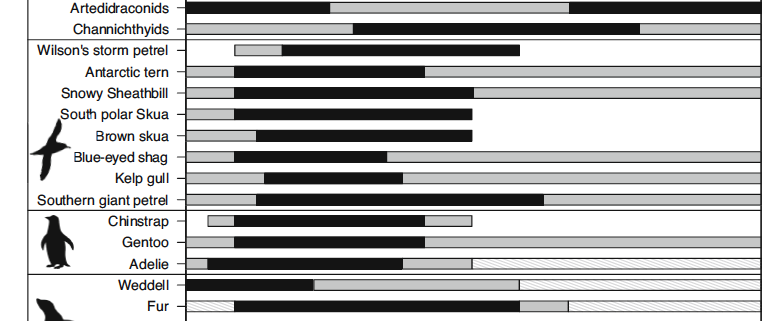New Paper: Long-term patterns in ecosystem phenology near Palmer Station
Congratulations to Megan Cimino and many other members of the PAL team who just had a new paper published in Ecosphere.
Here’s a quick snippet…
We show that sea ice retreat and increasing photoperiod in the spring trigger a sequence of events from mid-November to mid-February, including Adélie penguin clutch initiation, snow melt, calm conditions (low winds and warm air/sea temperature), phytoplankton blooms, shallow mixed layer depths, particulate organic carbon flux, peak humpback whale abundances, nutrient drawdown, and bacterial accumulation. Subsequently, from May to June, snow accumulates, zooplankton indicator species appear, and sea ice advances.
…
From an Adélie penguin perspective, earlier sea ice retreat and shifts in the timing of suitable conditions or prey characteristics could lead to mismatches, or asynchronies, that ultimately influence chick survival via their mass at fledging. However, more work is needed to understand how phenological shifts affect chick thermoregulatory costs and the abundance, availability, and energy content of key prey species, which support chick growth and survival. While we did not detect many long-term phenological trends, we expect that when sea ice trends become significant within our LTER time series, phenological trends and negative effects from ecological mismatches will follow.
Cimino, M. A., Conroy, J. A., Connors, E., Bowman, J., Corso, A., Ducklow, H., et al. (2023). Long‐term patterns in ecosystem phenology near Palmer Station, Antarctica, from the perspective of the Adélie penguin. Ecosphere, 14(2). https://doi.org/10.1002/ecs2.4417



 This site was developed with the support of the National Science Foundation under Grant No. OPP-2224611 and OPP-2026045. Any opinions, findings, and conclusions or recommendations expressed in this material are those of the authors and do not necessarily reflect the views of the National Science Foundation.
This site was developed with the support of the National Science Foundation under Grant No. OPP-2224611 and OPP-2026045. Any opinions, findings, and conclusions or recommendations expressed in this material are those of the authors and do not necessarily reflect the views of the National Science Foundation.
